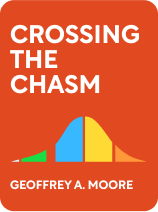

This article is an excerpt from the Shortform book guide to "Crossing the Chasm" by Geoffrey Moore. Shortform has the world's best summaries and analyses of books you should be reading.
Like this article? Sign up for a free trial here .
What is the “late majority” in the context of technology adoption? How does the late majority market adopt new technology?
The late majority is the group of customers who favor stability and familiarity over progress and novelty. They are not interested in new technology or the advantages it affords, but as it becomes standard and the technology that it replaces becomes obsolete, they will eventually upgrade to mitigate risk.
Learn about the characteristics of the late majority market.
The Late Majority
In his book Crossing the Chasm, Geoffrey Moore likes to call the late majority market “conservatives,” because they tend to value stability over progress: they only adopt new technology when it becomes mainstream.
- Population size: About one third of the population. More says they are almost as numerous as the early majority.
- Technical Competence: Moderately low. Moore says they tend to value simplicity and convenience over performance because they are less confident than the early majority in their ability to implement new technologies.
- Quality Requirements for your product: High. Moore observes that they require a product that is well-proven, thoroughly debugged, and widely supported across the industry.
- Price Sensitivity: High. As Moore points out, the early majority aren’t willing to spend much on new technology because they don’t expect to benefit from it.
- Whole-Product Perspective: According to Moore, the late majority are even more sensitive to missing parts of the whole product than the early majority are, because they are less competent at putting together the whole product.
- Product Positioning Perspective: Moore asserts that, because they value stability, the late majority tend to assess your product’s positioning based on how long they think it will be supported. To evaluate this, they consider its performance in industry to date, who else is using it, who is distributing and supporting it, and analysis provided by the business press.
Beal and Bohlen’s Perspective on the Late Majority
Beal and Bohlen’s original characterization refers to this category simply as the “majority,” rather than the “late majority.” Perhaps, where Moore identified the late majority as being slightly smaller than the early majority, Beal and Bohlen saw it as being slightly larger.
Then again, their nomenclature could also be a product of their method of analysis. When your product passes the peak of the bell curve into the region of the late majority, that implies that more than half of the total customers have adopted it. Thus, in a cumulative sense, selling to the late majority means your product has been adopted by the majority of the market. Beal and Bohlen displayed their customer categories on an S-shaped cumulative distribution curve, instead of on the bell curve that other analysts, such as Moore, used later. This could imply that they applied the term “majority” to the late majority in a cumulative sense.
In any case, Beal and Bohlen describe the late majority as typically being older and less educated than members of the preceding categories. They also describe them as less likely to read technical publications, hold positions of leadership within their communities, or communicate outside of their own community.
Their observations about technical publications and leadership positions is consistent with Moore’s assertion that they tend to be less technically competent and less confident in their ability to implement new solutions.
Moore does not discuss the relative age of the different categories. It may be that age became less relevant between the time of Beal and Bohlen’s research and the time of Moore’s writing. Perhaps generations that had experienced periods of technological stasis were more likely to be late adopters. Then, as the pace of technological advancement accelerated and the generation that was old enough to remember times of technological stasis died off, age would have ceased to be a defining quality of the late majority.
The Competence Gap Between the Early and Late Majority
According to Moore, the gap between the early and late majorities is relatively small, and is driven by their differing levels of technological competence. Specifically, the late majority are less confident in their ability to learn and implement new technologies, so they need solutions that are more user-friendly. Thus the gap between these two categories divides people who need more support (late majority) from people who need slightly less (early majority—although they still need more support than the early adopters).
| Symptoms of Reaching the Competence Gap Moore doesn’t explicitly address how you identify when you’ve reached this gap, but once again we can infer some symptoms from his description. For one thing, based on the size and distribution of the categories, you won’t hit this gap until your product is the market leader, with about 50% of the market share. Another symptom could be a sharp uptick in the demand on your tech support department, as more customers with less technical competence start buying your product. Yet another symptom could be if you detect an assimilation gap: People are buying your product because of pressure to keep up with industry standards, but they aren’t actually using it, or aren’t taking advantage of its full capabilities. |
The Gap Between the Late Majority and the Laggards
Moore does not discuss the gap between the late majority and laggards, although he does show this gap on his revised TALC figure. Presumably he did not consider this gap worthy of discussion because crossing it has little bearing on the success of a company or product: The gap is small and the laggards offer limited sales potential anyway.
However, he does mention in passing that one of the few ways to sell new technology to laggards is to integrate it into something they already use without their realizing it.
For example, maybe you’ve developed a smart stock tank for ranchers that uses a microprocessor and an electronic valve to keep the water trough at a certain level, and allows the rancher to monitor water levels across all his tanks from his smartphone. The laggards want nothing to do with your new system: they will stick with their old-fashioned stock tanks that use mechanical float-activated valves. However, if you develop a model with a lifetime battery that can be deployed just like a regular mechanical stock tank, your distributor may be able to sell it to laggards as a “plain old self-filling stock tank,” even though it uses your electronic valve system and has wifi capabilities that they don’t realize and won’t use.
Thus, we might infer that the gap between the late majority and the laggards is one of visibility: To cross the gap into laggard territory, the technology has to mature to the point where it doesn’t look like a new technology anymore. If it looks just like the same old thing that everybody’s been using all along, then the laggards may cease to be averse to it.

———End of Preview———
Like what you just read? Read the rest of the world's best book summary and analysis of Geoffrey Moore's "Crossing the Chasm" at Shortform .
Here's what you'll find in our full Crossing the Chasm summary :
- An explanation of the chasm phenomenon that many new high-tech products face
- How to pilot a product across this chasm to mainstream success
- The problems with the Technology Adoption Life Cycle (TALC) model






